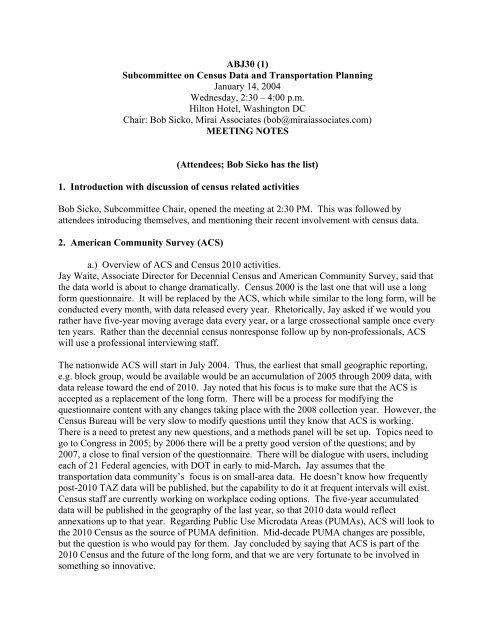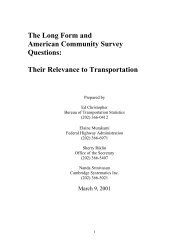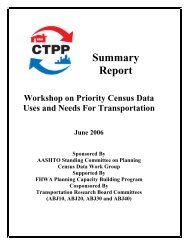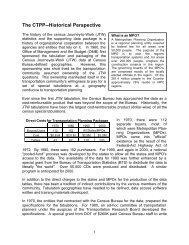Minutes - Census Data for Transportation Planning
Minutes - Census Data for Transportation Planning
Minutes - Census Data for Transportation Planning
You also want an ePaper? Increase the reach of your titles
YUMPU automatically turns print PDFs into web optimized ePapers that Google loves.
ABJ30 (1)<br />
Subcommittee on <strong>Census</strong> <strong>Data</strong> and <strong>Transportation</strong> <strong>Planning</strong><br />
January 14, 2004<br />
Wednesday, 2:30 – 4:00 p.m.<br />
Hilton Hotel, Washington DC<br />
Chair: Bob Sicko, Mirai Associates (bob@miraiassociates.com)<br />
MEETING NOTES<br />
(Attendees; Bob Sicko has the list)<br />
1. Introduction with discussion of census related activities<br />
Bob Sicko, Subcommittee Chair, opened the meeting at 2:30 PM. This was followed by<br />
attendees introducing themselves, and mentioning their recent involvement with census data.<br />
2. American Community Survey (ACS)<br />
a.) Overview of ACS and <strong>Census</strong> 2010 activities.<br />
Jay Waite, Associate Director <strong>for</strong> Decennial <strong>Census</strong> and American Community Survey, said that<br />
the data world is about to change dramatically. <strong>Census</strong> 2000 is the last one that will use a long<br />
<strong>for</strong>m questionnaire. It will be replaced by the ACS, which while similar to the long <strong>for</strong>m, will be<br />
conducted every month, with data released every year. Rhetorically, Jay asked if we would you<br />
rather have five-year moving average data every year, or a large crossectional sample once every<br />
ten years. Rather than the decennial census nonresponse follow up by non-professionals, ACS<br />
will use a professional interviewing staff.<br />
The nationwide ACS will start in July 2004. Thus, the earliest that small geographic reporting,<br />
e.g. block group, would be available would be an accumulation of 2005 through 2009 data, with<br />
data release toward the end of 2010. Jay noted that his focus is to make sure that the ACS is<br />
accepted as a replacement of the long <strong>for</strong>m. There will be a process <strong>for</strong> modifying the<br />
questionnaire content with any changes taking place with the 2008 collection year. However, the<br />
<strong>Census</strong> Bureau will be very slow to modify questions until they know that ACS is working.<br />
There is a need to pretest any new questions, and a methods panel will be set up. Topics need to<br />
go to Congress in 2005; by 2006 there will be a pretty good version of the questions; and by<br />
2007, a close to final version of the questionnaire. There will be dialogue with users, including<br />
each of 21 Federal agencies, with DOT in early to mid-March. Jay assumes that the<br />
transportation data community’s focus is on small-area data. He doesn’t know how frequently<br />
post-2010 TAZ data will be published, but the capability to do it at frequent intervals will exist.<br />
<strong>Census</strong> staff are currently working on workplace coding options. The five-year accumulated<br />
data will be published in the geography of the last year, so that 2010 data would reflect<br />
annexations up to that year. Regarding Public Use Microdata Areas (PUMAs), ACS will look to<br />
the 2010 <strong>Census</strong> as the source of PUMA definition. Mid-decade PUMA changes are possible,<br />
but the question is who would pay <strong>for</strong> them. Jay concluded by saying that ACS is part of the<br />
2010 <strong>Census</strong> and the future of the long <strong>for</strong>m, and that we are very <strong>for</strong>tunate to be involved in<br />
something so innovative.
Thabet Zakaria, DVRPC said that he has written a memorandum to the <strong>Census</strong> Bureau<br />
concerning his doubts that the ACS will provide data with the quality of the decennial census .<br />
Even with the larger sample size of <strong>Census</strong> 2000, he found problems in approximately ten<br />
percent of his municipalities. In addition, ACS will not have the benefit of the advertising and<br />
publicity, nor the questionnaires in as many languages that a decennial <strong>Census</strong> has. He<br />
recommended that USDOT do research on the data from the 3,000,000 households (and later the<br />
15,000,000) at TAZ level. [Note: In a subsequent review of Mr. Zakaria’s analysis it was<br />
learned that direct comparisons between the decennial census data and ACS should not be made.<br />
The ACS test sites did not include group quarters in<strong>for</strong>mation with the decennial data did.]<br />
b.) Using ACS <strong>Data</strong> <strong>for</strong> <strong>Transportation</strong>: NCHRP 08-48.<br />
Kevin Tierney, Cambridge Systematics, discussed the NCHRP project. The purpose of the<br />
project is to develop a guidebook <strong>for</strong> transportation planners about how to use ACS, adjust <strong>for</strong><br />
the loss of the long <strong>for</strong>m, and to identify new uses <strong>for</strong> the data. In<strong>for</strong>mation will be collected on<br />
how people have used CTPP data, how they plan to use CTPP 2000, and the changes entailed in<br />
using ACS data where the decennial census data have traditionally been used. The next steps<br />
include a detailed outline followed by analysis of workplace and worker flow data. A draft of<br />
the guidebook is to be available <strong>for</strong> the Spring 2005 TRB <strong>Census</strong> data conference in Irvine, CA.<br />
c.) Report on FHWA-sponsored research.<br />
Elaine Murakami stated that to augment the NCHRP project DOT has contracted with the<br />
<strong>Census</strong> Bureau <strong>for</strong> a special tabulation of the 3-year test ACS data. The tabulation is designed as<br />
a “mini CTPP” with a Part 1, Part 2 and Part 3 set. Although the data tabulation was developed<br />
to support the research associated with the NCHRP project, the data will also be made available<br />
to interested researchers<br />
Other research underway consists of two projects, one with Emily Parkany and another with Deb<br />
Neimeier. These two projects were conducted at a <strong>Census</strong> Bureau Research <strong>Data</strong> Center, one in<br />
Boston and the other in Berkeley, CA. They are nearing completion.<br />
d.) ACS analysis in San Francisco and Broward County, FL.<br />
Wende Mix, consultant, reported on an evaluation of 1991-2001 ACS data, using three-year<br />
averages compared to <strong>Census</strong> 2000 data. At the county level, trip characteristics showed no<br />
differences, except <strong>for</strong> average time to work. At the tract level, calculating a three-year average<br />
<strong>for</strong> place of work and worker flow data presented problems, especially when certain origindestination<br />
pairs have data in fewer than three years. Wende used a second approach to calculate<br />
three-year averages by imputation of the missing data. In addition, Wende suggested that using<br />
LED data could enhance ACS. Jay White commented that ACS data reflecting job<br />
concentrations will be better than <strong>Census</strong> 2000, but data <strong>for</strong> sparse job areas will not be as good.<br />
ACS will provide much higher quality answers, but there will be fewer of them.<br />
3. Committee Business. Besides the approval of last year’s meeting minutes, the following<br />
events were mentioned:<br />
a) <strong>Planning</strong> Applications Conference in Baton Rouge (April, 2003)<br />
b) Mid-year meeting, Portland, OR (July, 2003)
c) Mid-year meeting in conjunction with NATMEC, San Diego (June 27-30,2004)<br />
d) Poster Session, (Jan. 2003, Jan. 2004)<br />
e) TRB <strong>Census</strong> data conference, (Spring 2005)<br />
f) <strong>Transportation</strong> Applications Meeting , Portland, OR (Spring 2005)<br />
4. CTPP 2000<br />
a.) <strong>Data</strong> Release and Use.<br />
Phil Salopek, <strong>Census</strong> Bureau, reported that CTPP Part 1 data were sent out last year during July<br />
and August. The final Part 1 files will be made after the preliminary Part 2 CDs are distributed.<br />
BTS will handle the distribution of Part 1 CDs. Part 2 place of work data distribution is just<br />
starting. The distribution of Part 2 CDs with software should start by next week. Phil asked that<br />
recipients please look at both data and software, and get back to him with any problems. Part 3<br />
worker flow requires more work on the software, that could take another six weeks. Part 3<br />
distribution is expected to start in late March.<br />
b.) MPO use of <strong>Census</strong> products (CTPP, PUMS) <strong>for</strong> transportation modeling updates.<br />
Larry Blain, Puget Sound Regional Council, described his use of PUMS data <strong>for</strong> cross<br />
tabulation, and use of both PUMS and SF3 <strong>for</strong> urban simulation. Ken Cervenka, NCTCOG, will<br />
do reasonableness checks on the worker flow data, and use PUMS to analyze vehicle availability.<br />
Chuck Purvis, MTC, distributed a one-page handout describing four travel demand modeling<br />
applications using PUMS, five examples of exploratory research with PUMS as a key data<br />
source, and four other research ef<strong>for</strong>ts related to transit marketing, environmental justice, and<br />
household income by age of householder.<br />
5. Other.<br />
Ed Christopher stated that the CTPP list serve has new software which allows <strong>for</strong> easier member<br />
sign up, a digest function and better spam blocking. The listserve currently has 747 subscribers.<br />
6. Adjournment.<br />
Chair Bob Sicko adjourned the meeting at 4:03 PM.<br />
Respectfully submitted,<br />
Ed Limoges, Secretary









